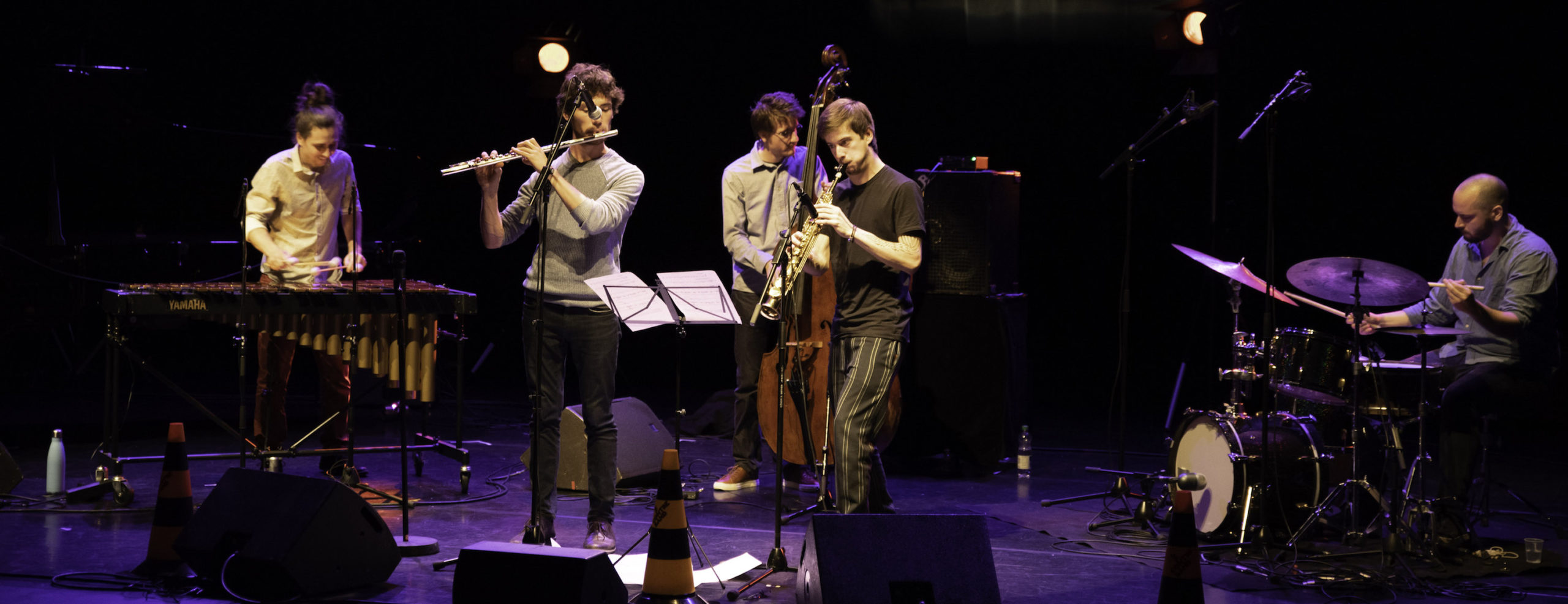
Created in 2018 in Lausanne, the Lenni Torgue 5tet is a jazz ensemble with cosmopolitan influences. This project is the culmination of a rich path through a variety of traditional music and the learned western music of the 20th century.
At the beginning, there is a passion for traditional music from Africa. Born into a family of musicians, I grew up at the crossroads of classical music, jazz and Afro-Cuban music. I was lucky enough to discover African percussions during a trip there at the age of 7. After that, I began to study classical percussion while keeping in mind the traditional percussion that I had just discovered.
As the various encounters punctuate my musical learning, I discover other horizons. The music of the Bwiti initiation rite of the Fang ethnic group of Gabon will be my first experience of fusion of elements of traditional music to a personal work, composition or arrangement. This first piece, entitled “Modal Bwiti”, is an arrangement I made in 2011 for a jazz trio. This piece was then readapted for the first version of my quintet in 2016.
This was followed by a meeting with Miguel Ballumbrosio, percussionist from El Carmen, Lima, ambassador of Afro-Peruvian music. Thanks to the discoveries of the African tradition of Peru through Miguel on the one hand, and the Andean Indian tradition through an Ecuadorian friend, I got the idea of a fusion between two cultures geographically close but historically far apart. The idea of this second piece, entitled “La Bocina de Los Andes” was to “stick” a traditional Afro-Peruvian rhythm, the festejo, to a traditional Andean song arranged for a jazz quintet. Created in 2014, I also adapted it in 2016 for my first quintet and in 2018 for the current formation.
In 2014, following my first trip to Africa where I discovered traditional Mandingo music, I moved to Paris to continue my musical studies. In parallel to my jazz studies at the conservatory, I join Ivan Ormond’s traditional Senegalese percussion classes and Sebastian Quezada’s traditional Afro-Cuban percussion classes. These two encounters, both human and musical, have left a deep impression on me and are the basis of my compositional research which led to the creation of my quintet.
These drumming traditions are an integral part of two very singular cultures and are very different in their sound results. However, they have stimulated similar musical qualities in me. Organized around a “drum leader”, a leader, a group of drummers plays on a variation of drums from the same family, thus obtaining different pitches and sounds. Essentially percussive, these traditions have developed an incredible rhythmic richness, passing very easily from one rhythm to another, from binary to ternary and vice versa, from accelerando to rallentando. All these changes are mainly initiated by the leader. They are often abrupt but are announced beforehand by a “call”. This “moto perpetuo” requires on the one hand an extreme reactivity and a tenfold attention, but also the knowledge of a “common repertoire” made of calls, “conversations”, “bàkks”, etc., and on the other hand the knowledge of a “common repertoire” made of “calls”, “conversations”, “bàkks”, etc.
The term bàkk comes from the sabar drum tradition of Senegal. It refers to a rhythmic-melodic phrase played in unison on all the drums. These phrases, whether or not preceded by a call, mark out a playing sequence and can be played at any time when the rhythm allows it. As early as 2016, I wanted to try to adapt this concept to a composition. Being inherently unpredictable, I wanted to transform these bàkks into melodies in order to make the shape of my piece more malleable and changeable. To do this, I first “put in melody” some bàkks of Doudou Ndiaye Rose. Often without appeal, I created some of them in order to fluidify the play of the composition. Finally, I integrated them into my piece as tutti following the different solos. Mainly initiated by the soloist himself in order to put an end to his own solo, they can also be initiated by another musician putting an end or not to the solo in progress. Thus, thought as a game where politeness is not required, each interpretation of the piece is unique, left to the musicians’ imagination.
This third piece was first entitled “Doudou’s Got rhythm” and then, after many adjustments, “Pray, Dance & Play”.
Just as the bàkks mark out a sequence of playing the sabar, my experiences in adapting elements of traditional music in my compositions mark out my career as a jazz musician. After having studied American jazz of the 1950s/60s for a long time in my early teens, I truly immerse myself in the material of contemporary New York jazz in 2017. Earlier, I had been introduced to odd rhythms, thanks in particular to the music of Dave Holland. However, I had never before analysed what made the harmonic colour of the music of Ambrose Akinmusire, Walter Smith III, Lionel Loueke, Aaron Parks or Joshua Redman.
These influences, although distilled throughout my compositions, are particularly recognizable in “LCT#1”.
To conclude the story behind my influences, in 2019 began an in-depth study of 20th century Western classical music in William Blank’s Contemporary Analysis class. This work has opened me to questions of timbre and sound texture which I have been able to experiment thanks to the original instrumentation of my quintet. Thus, in the piece “Ecrin”, I combined the flute with the soprano saxophone in order to create a new timbre where the two instruments would no longer be distinguished. Like “Valency”, these two compositions are imbued with the harmonic richness of Claude Debussy’s piano preludes mixed with my contemporary jazz influences.
From my experience, curiosity and openness to a vast musical horizon are essential qualities for a musician-composer. Once assimilated, these discoveries form a fertile substratum for creation, which nourished by multiple influences, is the reflection of a singular musical personality.


